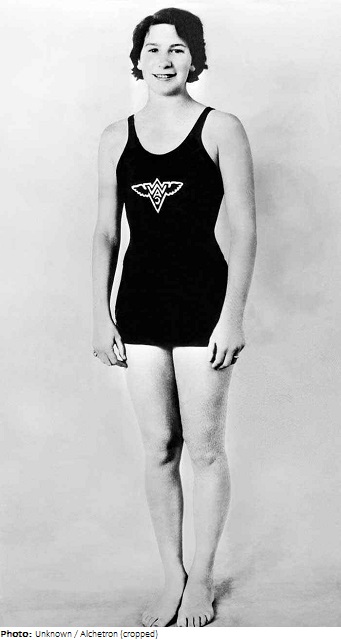Maria Lenk

Biographical information
| Roles | Competed in Olympic Games |
|---|---|
| Sex | Female |
| Full name | Maria Emma•Hulda Lenk Zigler |
| Used name | Maria•Lenk |
| Born | 15 January 1915 in São Paulo, São Paulo (BRA) |
| Died | 16 April 2007 in Copacabana, Rio de Janeiro (BRA) |
| Measurements | 168 cm |
| Affiliations | Associação Atlética São Paulo, São Paulo (BRA) / CR Tietê, São Paulo (BRA) |
| NOC |  Brazil Brazil |
Biography
Maria Lenk was a pioneer in women’s swimming. Lenk was the first Brazilian woman and the first from South America to compete at the Olympics. Lenk was also the first woman to use the butterfly stroke in an official competition and the first Brazilian woman to set a world record in swimming.
Lenk and her sister Sieglinde Lenk were daughters of German immigrants who came to Brazil in 1912. After contracting double pneumonia when she was 10, her parents thought that swimming would be good for her health. With no local swimming pools Lenk was taught how to swim in the Tietê River. In the early 1930s Lenk won four consecutive titles in the traditional 5.5km swimming race “Travessia de São Paulo a Nado”.
At the age of 17 Lenk became the first South American woman to compete at the Olympics when she took part at the 1932 Los Angeles Olympics. In Los Angeles Lenk swam in the 100 metres freestyle, the 100 metres backstroke, and the 200 metres breaststroke but failed to advance from the heats in each race. Four years later Lenk competed in the 200 metres breaststroke at the 1936 Berlin Olympics where she reached the semi-finals. In the breaststroke event in Berlin Lenk swam with the butterfly stroke – the first time it had been used in an international race. Butterfly was not yet recognised as a swimming stroke in its own right, with Lenk saying she was trying to develop a new way of swimming the breaststroke.
Following the Olympics Lenk went on to set world records in the breaststroke. In November 1939 Lenk set a world record in the 200 metres breaststroke, with the record lasting until August 1946. Also in 1939 Lenk set a world record in the now-discontinued 400 metres breaststroke. Lenk had reached her peak, but her dreams of winning an Olympic medal did not happen following the outbreak of World War II.
Despite the onset of war Lenk was part of a South American delegation of swimmers that toured the United States in the early 1940s. While in the US Lenk broke 12 North American swimming records and went to study physical education at the University of Illinois. Lenk retired from competitive swimming in 1942 but continued to enter Masters events. Even into her 90s Lenk swam nearly a mile every day.
In 1988 Lenk was inducted into the FINA Swimming Hall of Fame. In 2004 the Brazilian Olympic Committee bestowed her with the Adhemar Ferreira da Silva Trophy for lifetime achievement. In February 2007 Rio de Janeiro’s mayor named the city’s new aquatic centre after Lenk (“Parque Aquático Maria Lenk”), with the venue being used to host events at the 2007 Pan American Games and the 2016 Rio de Janeiro Olympics.
Results
| Games | Discipline (Sport) / Event | NOC / Team | Pos | Medal | As | |
|---|---|---|---|---|---|---|
| 1932 Summer Olympics | Swimming (Aquatics) |  BRA BRA |
Maria Lenk | |||
| 100 metres Freestyle, Women (Olympic) | 5 h4 r1/3 | |||||
| 100 metres Backstroke, Women (Olympic) | AC h2 r1/2 | |||||
| 200 metres Breaststroke, Women (Olympic) | 4 h3 r1/2 | |||||
| 1936 Summer Olympics | Swimming (Aquatics) |  BRA BRA |
Maria Lenk | |||
| 200 metres Breaststroke, Women (Olympic) | 7 h1 r2/3 |
Olympic family relations
- Sister of Sieglinde Lenk
Special Notes
- Listed in Olympians Who Set a World Record in Long Course Swimming (200 m breaststroke – 8 November 1939 - 19 March 1941: 2:56.0 (8 November 1939; Rio de Janeiro, BRA))
- Listed in First Female Competitors at the Olympics by Country (First woman to compete for Brazil)
- Listed in Olympic Order Recipients (2000 (Silver))